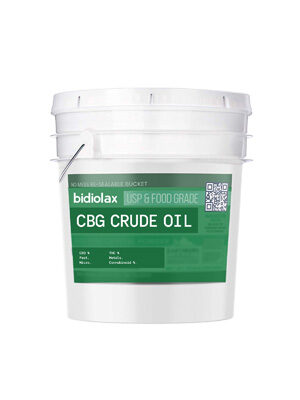CBG Crude Oil
CBG Crude Oil (Cannabigerol)
Cannabigerol is a highly refined cannabis extract often derived from high CBD hemp flower and hemp biomass
Cannabigerol is the non-acidic form of cannabigerolic acid, the parent molecule from which other cannabinoids are synthesized. Cannabigerol is a minor constituent of cannabis.
What is CBG?
Cannabigerol, or CBG, is a non-psychoactive cannabinoid typically most abundant in low-THC and high-CBD cannabis strains, including hemp. Like THC, CBG reacts with the cannabinoid receptors in the brain. CBG, however, acts as a buffer to the psychoactivity of THC by working to alleviate the paranoia sometimes caused by higher levels of THC. CBG acts as a chemical precursor to other cannabinoids such as THC and CBD. This conversion typically takes place 6-8 weeks in the flowering cycle. CBG is present only in trace amounts in most cannabis strains, however some hemp strains are specifically cultivated to generate higher yields of this cannabinoid.
CBG displays a multitude of potential health benefits including working as a neuroprotectant, having antioxidant properties, aiding with skin ailments as an antibacterial and antifungal agent, appetite stimulation, treatment of gastrointestinal disorders, inflammation reduction, shows promise in fighting cancer, and lowering intraocular pressure, which may benefit glaucoma patients.
CBG also works to fight inflammation, pain, nausea and works to slow the proliferation of cancer cells. Research has shown it also significantly reduces intraocular eye pressure caused by glaucoma. Strains high in CBG will be beneficial treating conditions such as inflammatory bowel disease, Crohn’s disease, and cancer.
Effects and Benefits
Research has shown that CBG is effective in the treatment of a variety of symptoms and conditions. Examples of conditions for which CBG is particularly effective in providing symptom relief are listed below:
- Glaucoma
- Cancer
- Crohn’s disease
- irritable bowel syndrome
What is CBG?
Cannabigerol (CBG) is a non-psychoactive cannabinoid that plays an important role in the biochemistry of the cannabis plant. CBG acts as a chemical precursor to other cannabinoids such as THC and CBD. This conversion typically takes place 6-8 weeks in the flowering cycle. CBG is present only in trace amounts in most cannabis strains, however some hemp strains are specifically cultivated to generate higher yields of this cannabinoid.
CBG displays a multitude of potential health benefits including working as a neuroprotectant, having antioxidant properties, aiding with skin ailments as an antibacterial and antifungal agent, appetite stimulation, treatment of gastrointestinal disorders, inflammation reduction, shows promise in fighting cancer, and lowering intraocular pressure, which may benefit glaucoma patients.
How Does CBG Work?
CBG interacts with both the CB1 and CB2 receptors, acting as a possible inhibitor to the psychoactive effects of THC. CBG is also thought to boost anandamide, an endocannabinoid that naturally increases dopamine levels and responsible for regulating various health functions such as mood, sleep, and appetite. GABA uptake in the brain may be obstructed by CBG, making this cannabinoid a possible anti-anxiety agent and muscle relaxant. CBG may also block serotonin receptors, showing potential antidepressant traits.
CBG holds promise to be a key constituent in the overall medicinal benefits cannabis may provide. As cannabis research continues to rapidly evolve, CBG may emerge as one of the most therapeutically applicable and diverse cannabinoids to offer a wide range of possible remedies. Feel free to ask any of our knowledgeable patient consultants with any questions you may have.


